
“The EU FP7 large-scale integrating project NanoValid started on the 1st of November 2011, as one of the „flagship“ nanosafety projects. The project consists of 24 European partners from 14 different countries and 6 partners from Brazil, Canada, India and the US and will run from 2011 to 2015, with a total budget of more than 13 mio EUR (EC contribution 9.6 mio EUR). Main objective of NanoValid is to develop a set of reliable reference methods and materials for the fabrication, physicochemical (pc) characterization, hazard identification and exposure assessment of engineered nanomaterials (EN), including methods for dispersion control and labelling of ENs. Based on newly established reference methods, current approaches and strategies for risk and life cycle assessment will be improved, modified and further developed, and their feasibility assessed by means of practical case studies.”
(Text quoted from the official website, www.nanovalid.eu, where further information is available.)
Our own group focuses on the transfer of cell-based methods for the assessment of potential nanohazards from the laboratory to working-place environments. This requires to establish robust test systems which can either be set up on-site (i.e. without extensive laboratory facilities) or to use particle samples collected on site (which requires to deal with biological and non-biological contaminants as well as with particle aging). These studies will be extended to include measurements within large-scale accident scenarios, for which at present safety assessment procedures are lacking. 
Teaching kids about nanoparticles at the „Lange Nacht der Forschung 2012“, Salzburg
 This project is supported by the European Commission
This project is supported by the European Commission




